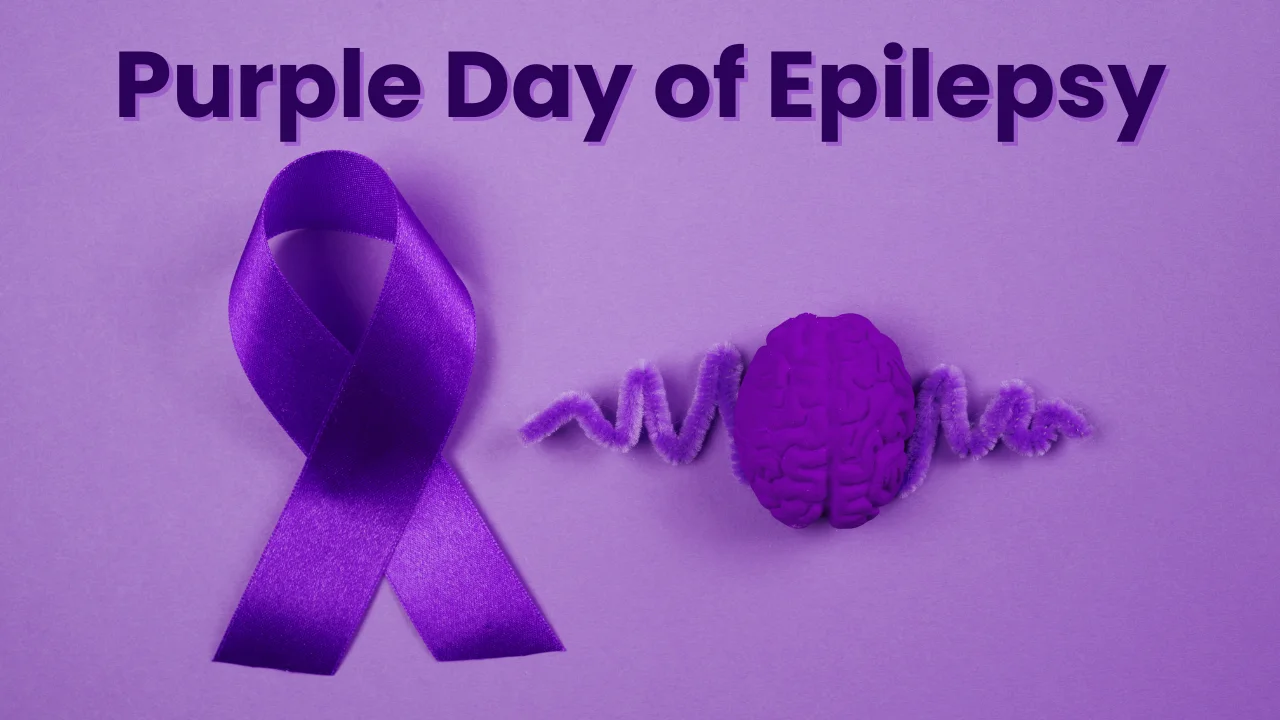Purple Day of Epilepsy 2024
Purple Day of Epilepsy, a global campaign raising awareness for epilepsy, is just around the corner on March 26, 2024. This day is dedicated to raising awareness about epilepsy, a neurological condition that affects millions of people worldwide.
Purple Day of Epilepsy Theme 2024
The official theme for Purple Day of Epilepsy 2024 is “Lets Talk About Epilepsy“. This powerful theme emphasizes the importance of open communication and breaking down the stigma surrounding epilepsy.
The #LetsTalkAboutEpilepsy theme encourages everyone to engage in open and honest conversations about epilepsy, from casual discussions with friends and family to larger initiatives in schools, workplaces, and communities. By fostering dialogue and understanding, we can create a world where epilepsy is no longer a source of fear or shame, but simply a medical condition that can be managed with proper support.
What is Epilepsy
Epilepsy is a chronic neurological condition characterized by recurrent seizures. Seizures are temporary disturbances in the electrical activity of the brain, causing a variety of physical and psychological symptoms. People of all ages, genders, and backgrounds can be affected by epilepsy, making it a significant global health concern.
Causes and Symptoms
The exact cause of epilepsy remains unknown in many cases. However, potential factors include:
- Genetics
- Head injury
- Brain infection
- Stroke
- Developmental brain abnormalities
Symptoms of seizures vary greatly depending on the location and severity of the electrical disturbance in the brain. Common symptoms include:
- Convulsions
- Loss of consciousness
- Staring spells
- Sensory disturbances
- Confusion
- Automatic behaviors
Diagnosis and Treatment
An accurate diagnosis of epilepsy is crucial for receiving proper treatment. Diagnosis involves a comprehensive medical history, physical examination, and neurological tests like electroencephalograms (EEGs) and neuroimaging.
Several effective treatment options are available for epilepsy, including:
- Anti-seizure medications: These medications help control the electrical activity in the brain and reduce the frequency and severity of seizures.
- Surgery: In some cases, surgery may be considered to remove the area of the brain causing seizures.
- Vagus nerve stimulation (VNS): This non-invasive treatment involves implanting a device that stimulates the vagus nerve to reduce seizure frequency.
- Ketogenic diet: This specialized diet may help control seizures in some children.
Living with Epilepsy
Epilepsy can significantly impact individuals’ lives, affecting their social, emotional, and educational experiences. However, with proper management and support, people with epilepsy can live fulfilling and productive lives. Here are some ways to manage epilepsy:
- Adhere to treatment plans: Taking medications as prescribed and attending regular doctor appointments are crucial for controlling seizures.
- Get enough sleep: Adequate sleep is essential for managing epilepsy as sleep deprivation can trigger seizures.
- Manage stress: Stress can exacerbate seizures, so relaxation techniques like meditation and yoga can be beneficial.
- Stay informed and connected: Participating in support groups and online communities can offer valuable information, resources, and emotional support.
Raising Awareness and Reducing Stigma
Epilepsy is often misunderstood and stigmatized. International Epilepsy Day, celebrated on the second Monday of February each year, aims to raise awareness, promote understanding, and challenge societal misconceptions. By sharing knowledge and personal stories, we can create a more inclusive environment where people with epilepsy feel supported and empowered to reach their full potential.
History of Purple Day of Epilepsy
The vibrant purple hue of Purple Day illuminates a journey of bringing awareness and understanding to epilepsy, a neurological condition affecting millions worldwide. Let’s dive into the history of this impactful campaign:
Seeds of Advocacy
- 2008: A young Canadian girl named Cassidy Megan, diagnosed with epilepsy at a young age, witnessed the stigma and lack of understanding surrounding the condition. Determined to make a difference, she sparked the idea of Purple Day.
- Inspiration: Lavender, chosen as the international flower of epilepsy, became the inspiration for the campaign’s color, symbolizing hope, peace, and dignity.
Global Momentum
- First Purple Day: Held on March 26th, 2008, the inaugural Purple Day witnessed enthusiastic participation in Canada, with Cassidy spearheading events to raise awareness and educate people about epilepsy.
- Rapid Expansion: News of the Day spread like wildfire, and within a few years, Purple Day reached countries across continents, uniting individuals and organizations for a common cause.
Evolving Impact
- Annual Themes: Each year, a unique theme guides the Day’s activities and discussions. It addresses diverse aspects of epilepsy, from challenging misconceptions to promoting research and advocating for improved care.
- Community Building: Purple Day fosters a global community of individuals with epilepsy, their families, caregivers, healthcare professionals, and supporters, all working together to break down barriers and build a better future.
Looking Ahead
Purple Day continues to evolve, serving as a platform for advocacy, education, and celebration. As we strive towards a more inclusive world, this vibrant campaign reminds us that epilepsy should not be a barrier to living a fulfilling life.
By embracing the spirit of Purple Day and actively participating in its initiatives, we can all contribute to a brighter future for individuals with epilepsy, one filled with understanding, support, and hope.
Significance of Purple Day of Epilepsy
Over a decade since its inception, Purple Day has grown into a powerful movement with a lasting impact:
- Increased Awareness: The Day has significantly raised public awareness about epilepsy, its symptoms, management, and the challenges faced by those living with it.
- Reduced Stigma: Open discussions and shared experiences have helped break down the stigma surrounding epilepsy, creating a more supportive and inclusive environment.
- Funding and Research: Purple Day initiatives have contributed to valuable research efforts aimed at improving epilepsy diagnosis, treatment, and ultimately, finding a cure.
- Advocacy and Policy Change: The Day has inspired advocacy efforts leading to improvements in healthcare access, education, and employment opportunities for people with epilepsy.
26th March 2024 Special Day
March 26, 2024, marks the Purple Day of Epilepsy, a global campaign shedding light on epilepsy, a neurological condition impacting millions worldwide. Dedicated to raising awareness, this day serves as a platform to educate communities about epilepsy’s challenges and advocate for support and understanding. Through collective action and solidarity, Purple Day aims to reduce stigma, foster empathy, and empower those living with epilepsy to lead fulfilling lives.
- SSC CGL Exam Centers 2025 for Tier 1 and Tier 2, Choose Preferences
- SSC CGL Vs CAT, Which is the Better Career Option?
- SSC Typing Test – How to Attempt SSC Typing Test, Check Strategy
- SSC CGL vs IBPS PO Complete Comparison, Which is Better?
- Active Passive Voice for SSC Exams, Practice Questions with Solutions
- SSC Registration Number, Know How to Get Your Registration Number

Hello, I’m Aditi, the creative mind behind the words at Oliveboard. As a content writer specializing in state-level exams, my mission is to unravel the complexities of exam information, ensuring aspiring candidates find clarity and confidence. Having walked the path of an aspirant myself, I bring a unique perspective to my work, crafting accessible content on Exam Notifications, Admit Cards, and Results.
At Oliveboard, I play a crucial role in empowering candidates throughout their exam journey. My dedication lies in making the seemingly daunting process not only understandable but also rewarding. Join me as I break down barriers in exam preparation, providing timely insights and valuable resources. Let’s navigate the path to success together, one well-informed step at a time.






